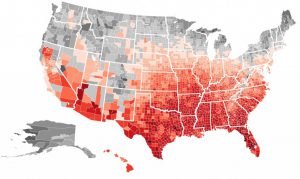Estimating the costs of the trends to a warmer climate which we have seen since the 1970’s is difficult because there are so many factors involved in how a warmer climate might affect things like agriculture, energy production, etc. And of course they are moving targets because people can and do adapt to these changes by changing the crops they grow, how they make and conserve energy, and where they live. But it is still a useful exercise to determine what those costs might be, because they will affect communities’ ability to fund future development and emergency services, among other things. Governing.com has an interactive map which provides county-by-county breakdowns of the cost of a warmer climate broken down by agriculture, energy use, coastal damages, labor, crime and mortality at https://www.governing.com/topics/transportation-infrastructure/gov-counties-climate-change-damages-economic-effects-map.html. You can see from the map that the southern part of the United States is disproportionately affected, mainly because of increases in temperature and the adverse effects they will have on crops, labor, and air conditioning costs.
A report from the US Government Accountability Office released this week also discusses the costs that a changing climate will impose on the US in the future. You can read more about that at Time.com at https://time.com/4994494/us-climate-change-cost-gao-report/#. Yahoo News also has a story here.
